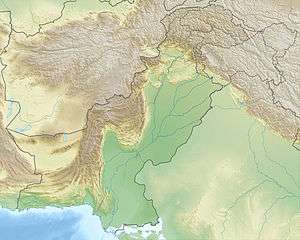Tirich Mir
| Tirich Mir | |
|---|---|
 | |
| Highest point | |
| Elevation |
7,708 m (25,289 ft) Ranked 33rd |
| Prominence |
3,908 m (12,822 ft) [1] Ranked 30th |
| Isolation | 239 kilometres (149 mi) |
| Listing | Ultra |
| Coordinates | 36°15′15″N 71°50′36″E / 36.25417°N 71.84333°ECoordinates: 36°15′15″N 71°50′36″E / 36.25417°N 71.84333°E [1] |
| Geography | |
 Tirich Mir Location in Pakistan | |
| Location | Pakistan |
| Parent range | Hindu Kush |
| Climbing | |
| First ascent | 1950 |
| Easiest route | glacier/snow/ice |
Tirich Mir (Pashto/Khowar/Urdu: ترچ میر) (alternatively Terich Mir, Terichmir and Turch Mir) is the highest mountain of the Hindu Kush range, and the highest mountain in the world outside of the Himalayas-Karakoram range, located in Khyber Pakhtunkhwa, Pakistan. The mountain was first climbed in 1950 by a Norwegian expedition consisting of Arne Næss, P. Kvernberg, H. Berg, and Tony Streather. Tirich Mir overlooks Chitral town, and can be easily seen from the main bazaar.
The last village in Chitral before reaching Tirich Mir is the village of Tirich. It is located in Mulkow. The people there speak the Khowar language. The residents are available for hire as porters and tourist guides and will lead trekkers part way up the mountain, but there is a point beyond which they will not go.
It is believed the origin of the name Tirich Mir is "King of Tirich" as Tirich is the name of a side valley of the Mulkhow valley of Chitral which leads up to Tirich Mir. An alternative etymology derives its name from the Wakhi language. In Wakhi trich means shadow or darkness and mir means king so Tirich Mir means king of darkness. It could have got this name as it causes long shadows on the Wakhan side of its face.
Climate
Tirich is the coldest weather experiencing an altitude-influenced subarctic climate. There is low oxygen in this area due to high elevation. Winters are cold with average lows around −22 °C (−10 °F), and as low as −35 °C at the height of winter, which lasts from mid-October to mid-May. Summers start in June and go on up till early September, with average temperatures near 15 °C (60 °F) and little precipitation. Annual precipitation is almost entirely concentrated in the months from December to May when Tirich gets around 550 millimetres (21.7 in) water equivalent of snowfall.
| Climate data for Tirich | |||||||||||||
|---|---|---|---|---|---|---|---|---|---|---|---|---|---|
| Month | Jan | Feb | Mar | Apr | May | Jun | Jul | Aug | Sep | Oct | Nov | Dec | Year |
| Record high °C (°F) | 5 (41) |
6 (43) |
10 (50) |
18 (64) |
25 (77) |
30 (86) |
33 (91) |
31 (88) |
29 (84) |
25 (77) |
15 (59) |
9 (48) |
33 (91) |
| Average high °C (°F) | 5 (41) |
6 (43) |
7 (45) |
14 (57) |
17 (63) |
21 (70) |
27 (81) |
24 (75) |
20 (68) |
13 (55) |
4 (39) |
1 (34) |
27 (81) |
| Average low °C (°F) | −12 (10) |
−10 (14) |
−15 (5) |
−6 (21) |
1 (34) |
6 (43) |
9 (48) |
10 (50) |
5 (41) |
−1 (30) |
−10 (14) |
−19 (−2) |
−5 (23) |
| Record low °C (°F) | −35.4 (−31.7) |
−30 (−22) |
−31 (−24) |
−25 (−13) |
−17 (1) |
−8 (18) |
−5 (23) |
−6 (21) |
−7 (19) |
−20 (−4) |
−29 (−20) |
−37 (−35) |
−35.4 (−31.7) |
| Average precipitation mm (inches) | 96.5 (3.799) |
99.6 (3.921) |
137.1 (5.398) |
104.1 (4.098) |
60.9 (2.398) |
22.3 (0.878) |
15.2 (0.598) |
16.2 (0.638) |
17.7 (0.697) |
20.3 (0.799) |
32.5 (1.28) |
53.3 (2.098) |
675.7 (26.602) |
See also
- Khyber-Pakhtunkhwa
- List of mountains in Pakistan
- List of highest mountains
- List of Ultras of the Western Himalayas
References
- 1 2 "Afghanistan and Pakistan Ultra-Prominence". peaklist.org. Retrieved 2014-01-03.
Books
- Keay, John, "The Gilgit Game": The Explorers of the Western Himalayas, 1865-95, Oxford University Press, 1985, ISBN 0-19-577466-3
- Robertson, Sir George Scott, The Kafirs of the Hindukush, Oxford University Press, (1896, OUP edition 1986), ISBN 0-19-577127-3